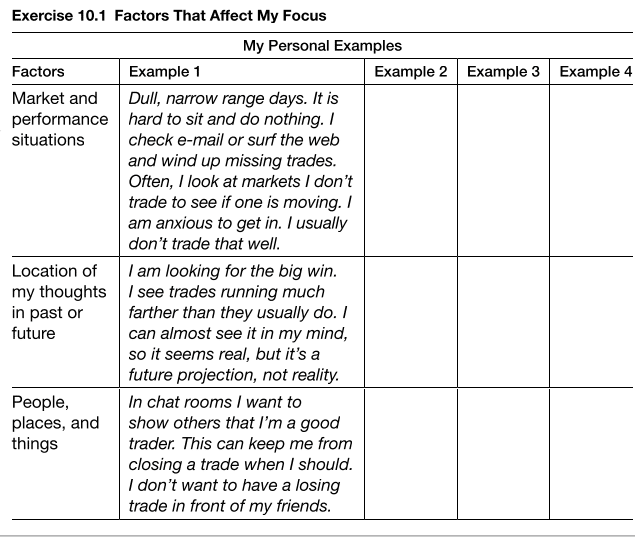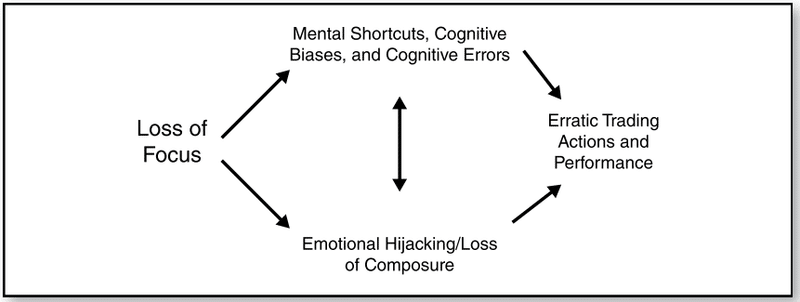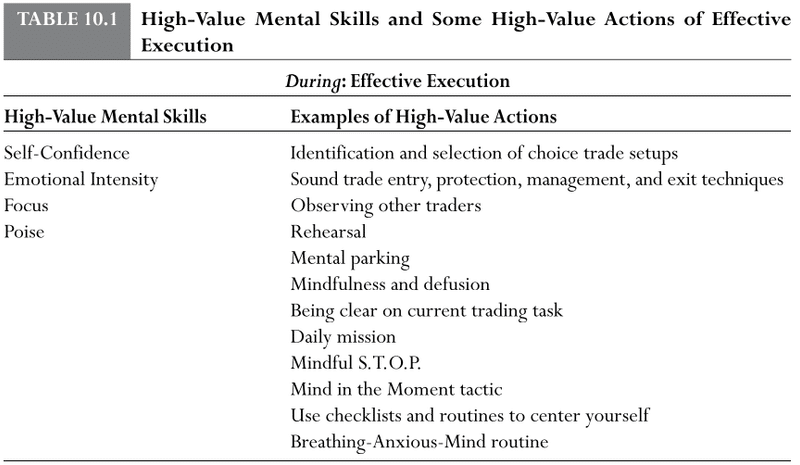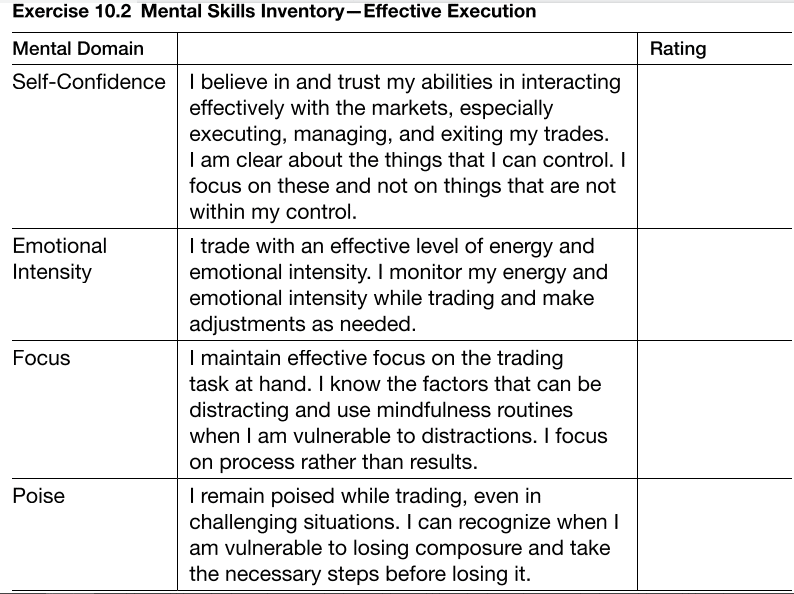
「Trade Mindfully」を読む(12)第10章
Chapter 10
The Trading Psychology Process: Effective Execution
This was a process‐oriented eff ort. His primary goal was not to make more profit, but to improve his trade exit strategy. He did use trading results to measure and evaluate the effectiveness of his strategy, but it was his strategy that he looked to improve. He knew that if he could develop a better exit strategy, profi ts would take care of themselves.
これはプロセス重視の努力だった。彼の第一の目標は利益を上げることではなく、トレードの出口戦略を改善することだった。彼は自分の戦略の有効性を測定・評価するためにトレード結果を使ったが、彼が改善しようとしたのは自分の戦略だった。より良い出口戦略を開発できれば、利益は自ずとついてくるということを彼は知っていた。
3つの時間枠のうち
2つ目のトレード中のパフォーマンスを最大化するために
身につけるべきメンタル特性
Self-Confidence 自信
Emotional Intensity テンション
Focus 集中力
Poise 冷静さ
Self-Confidence 自信
There are two kinds of confidence in trading: external confidence and internal confidence. Externally confident traders base their confidence on things outside of themselves, such as the money they make or the number of winning trades they have. Tying our confi dence to external factors, however, can be problematic.
トレードにおける自信には、外的な自信と内的な自信の2種類がある。外的な自信を持つトレーダーは、儲けや勝ちトレードの回数など、自分の外側にあるものを自信の根拠とする。しかし、自信を外的要因に結びつけることには問題がある。
When we allow our confidence to be based on things outside of ourselves we subject our confidence to the vagaries of things beyond our control.
自信を自分以外のものに依存させるとき、その自信は自分ではコントロールできない気まぐれにさらされることになる。
When your confidence is tethered to the results of your trading it will rise when results are positive and fall when they are negative.
自信とトレード結果が結びついている限り、トレード結果がプラスになれば自信は高まり、マイナスになれば自信は失われる。
Internal confidence is process based. It comes from three things you have complete control over: the knowledge you acquire, the skills you develop, and the ability to apply your knowledge and skills in the market. Internal confidence comes from within as a discernment of self‐efficacy in your ability to organize yourself and take the necessary actions to trade.
内的自信はプロセスに基づくものである。それは、完全にコントロールできる3つのもの、すなわち、習得する知識、開発するスキル、そして知識とスキルを市場で応用する能力から生まれる。内的自信は、自分自身を律し、トレードに必要な行動をとる能力に対する自己効力感の見極めとして、内面から生まれる。
True confidence is based on what matters over the long haul. Remember, trading is all about probabilities. What works over the long term in probabilistic fields of endeavor is developing and adhering to a process which you can control, rather than focusing on results, which cannot be controlled. For traders, fostering confidence has to be based on the process of developing, honing, and applying your trading knowledge, skills, and abilities—both mental and technical, in other words, the Before-During‐After process. True self‐confidence, therefore, is grounded in process not results. In a very real sense, when you focus on process, you are in control of your self‐confidence.
真の自信とは、長期にわたって何が重要であるかに基づいている。覚えておいてほしいのは、トレードは確率がすべてだということだ。確率的な努力の分野で長期的に有効なのは、コントロールできない結果に焦点を当てるのではなく、自分でコントロールできるプロセスを開発し、それに忠実であることだ。トレーダーにとって、自信を育むことは、トレードの知識、スキル、能力(メンタルとテクニカルの両方)を開発し、磨き、応用するプロセス、言い換えれば、「トレード前」「トレード中」「トレード後」のプロセスに基づいていなければならない。従って、真の自信とは、結果ではなく、プロセスに基づくものである。本当の意味で、プロセスに集中することで、自信をコントロールすることができる。
テンション Emotional Intensity
Emotional intensity refers to the ability of the trader to trade at a level of emotional energy that is effective for the trader. You want to be able to recognize when your emotions are too high, too low, or just right to trade. Just as important, you need to be able to make adjustments that help you “psych yourself up” when energy is running too low and tone yourself down when it is running too high.
適切なテンションとは、トレーダーが効果的なレベルの感情エネルギーでトレードできる能力を指す。トレーダーは、自分のテンションが高すぎるとき、低すぎるとき、あるいはトレードするのにちょうどいいときを認識できるようになりたい。同様に重要なのは、テンションが低すぎるときには「自分を奮い立たせ」、高すぎるときには「自分を抑える」調整ができるようになることだ。
You may, for example, become bored when the market is trading sideways and feel your energy drop. Conversely, you may become overly excited when about to take a trade or when in a trade. Whatever the case may be, begin to pay attention to your emotional energy level and how it varies. Be sure to pinpoint differences in thoughts and feelings when monitoring emotional intensity.
例えば、マーケットが横ばいで推移しているときに退屈になり、テンションが低下するのを感じるかもしれない。逆に、トレードをしようとしているときや、トレード中に過度に興奮することもあるだろう。どのような場合であれ、自分の感情のエネルギーレベルとその変化に注意を払うようこころがけよう。テンションをモニターする際には、思考や感情の違いを正確に把握するようにしよう。
スポーツ選手に学ぶイメトレ
Traders can also use rehearsal to create individual scenarios for preparing to trade and for actual trading with effective emotional intensity. As we discussed regarding self‐confidence, rehearsal has you visualize what you expect to see and how you will act in advance in taking and managing trades. In addition to rehearsing your actions, rehearse what you say to yourself, and what energy level you want to experience. This will help you be aware of and adjust your emotional energy to a beneficial level. One rehearsal scenario, for example, would involve a sideways market that suddenly starts to move. Rather than feel your emotional energy levels become swept up in the market excitement, a trader might rehearse patience and waiting for a confirming pullback, seeing in advance how price, volume, and indicators would be expected to act, along with using calming techniques (discussed below under poise and composure) to keep emotional intensity on an even keel. Virtually any trading situation that affects emotional intensity can be rehearsed in this way. It is a form of exposure which, as discussed earlier, is a powerful technique.
トレーダーはまた、エントリーのシナリオを作るときに、どんなテンションでエントリーするのかまでをリハーサル(イメトレ)することが効果的だ。リハーサルでは、取引を行い、管理する際に、自分が何を期待し、どのように行動するかを事前にイメージする。自分の行動をリハーサルするだけでなく、自分に何を言うのか、どのようなテンションを経験したいのかをリハーサル(イメトレ)する。こうすることで、自分の感情のエネルギーを意識し、有益なレベルに調整することができる。リハーサルのシナリオのひとつは、たとえば、横ばい相場が突然動き出すというものだ。トレーダーは、感情のエネルギーレベルが市場の興奮に振り回されるのを感じるのではなく、価格、出来高、インジケーターがどのように動くと予想されるかを事前に確認し、感情を落ち着かせるテクニック(「冷静さと落ち着き」で後述)を使って、テンションを平静に保つとともに、忍耐強く、確証のあるプルバックを待つ練習をするかもしれない。
スポーツ選手に学ぶエラーのリセット
Athletes use mental parking as a foundational technique for mental focus and energy management during play. A tennis player, for example, hits an errant shot and loses the point. You will often see her pick up an extra tennis ball after the point is over, look intently at it mentally placing the error into the ball, and then hit the ball off into the opposite court. She is mentally parking her error.
アスリートは「メンタルパーキング」を、プレー中の精神集中とエネルギー管理の基礎技術として用いる。例えば、テニス選手がショットをミスしてポイントを失ったとする。ポイントが終わった後、彼女がテニスボールを拾い上げ、そのボールを真剣にみつめ、たった今のミスをそのボールに精神的にこめて、そしてボールを反対側のコートに打ち落とすのをよく見かけるだろう。この行為が「メンタルパーキング」である。
You might see a baseball pitcher grind his foot into the dirt after throwing a poor pitch. He is parking the miss‐thrown ball. A basketball player might be seen wiping his hand across the leg of his shorts wiping away an error. The physical action of mental parking is useful as it tells the mind to set the mistake aside for now and return our focus to what’s important at that moment.
野球のピッチャーが悪い球を投げた後、足を土にすりつけるのを見るかもしれない。彼はミススローしたボールを「メンタルパーキング」しているのだ。バスケットボール選手がショーツの裾を手で拭いて「メンタルパーキング」するのを見るかもしれない。メンタルパーキングという物理的な動作は、ミスをひとまず脇に置き、いまの瞬間に重要なことに集中するよう心に伝えるものとして有効である。
(ケメコ注)
メンタルパーキング(mental parking)は
スポーツ心理学の用語
適切な訳語が見つからないけど
平たく言えば「リセット」するってこと
プレー中にミスやエラーしたら
即座に気持ちを切り替えて「リセット」する
そしてプレーに戻る
トレードにもこれを取り入れましょう、と
自分なりの体の合図 行動や動作を決めておいて
トレードでミスったり損切りにあったら
その動作・行動をとることで
瞬時に気持ちを切り替え「リセット」して
トレードに戻る
Traders can mentally park a mistake or a loss by taking a moment to write it
down in their journal. The physical action of writing it down is just like the tennis player mentally placing the error onto a tennis ball. We then close the cover on our notebook and signal the mind that it is time to return to the market and our trading, not dwell on the loss or mistake. Because we have written it down, the error will be there for us to review after trading is over. Mental parking is a useful psychological tool for traders.
トレーダーは、ミスや損失を日誌に書き留めることで、精神的に整理することができる。書き留めるという物理的な動作は、テニスプレーヤーがテニスボールの上にミスを転化するのと同じである。そしてノートの表紙を閉じたら、損失やミスにとらわれず、マーケットやトレードに戻る時だと心に合図を送る。書き留めておくことで、取引終了後にそのミスを見直すことができる。
スポーツ選手に学ぶ準備運動
We see athletes get ready for the next ball all the time. A baseball batter will take a few practice swings before stepping into the batter’s box and, once in the box, he will set his feet and take a slow swing or two just before the next ball is pitched. This is the batter’s ‘get ready.’ Outfi elders will lean forward, assume an athletic stance, and hold their hands out in front of their body in anticipation of the ball being hit so they can spring into action immediately if the ball is hit near their fi eld. A tennis player about to serve will bounce the ball a few times as they ready themselves to make a serve and the receiver will assume an athletic stance and take a small hop known as the split step just as the server hits the ball to ready themselves to return the serve. Getting ready puts the athlete’s mind and body in sync with the game and gives them an edge in making the next play.
スポーツ選手が次のボールに備える姿をいつも見ている。野球のバッターは、バッターボックスに入る前に何度か練習スイングをし、バッターボックスに入ったら、次のボールが投球される直前に足をセットしてゆっくりスイングをする。これがバッターの「準備運動」である。外野手は前傾姿勢になり、ボールが打たれるのを予期して両手を体の前に出し、自分の体の近くにボールが打たれたらすぐに行動に移せるようにする。サーブを打とうとするテニスプレーヤーは、サーブを打つ準備としてボールを数回バウンドさせ、レシーバーは、サーブを返す準備として、サーバーがボールを打つ瞬間に、アスレチックスタンスをとり、スプリットステップと呼ばれる小さなホップをする。準備をすることで、選手の心と体がゲームに同調し、次のプレーをする上で優位に立つことができる。
A trader can get ready by planting both feet squarely on the fl oor and leaning forward in their chair. Some traders like to wear a hat while trading and this could be put on as a part of the get ready. An alternative is to adjust your glasses, take hold of the computer mouse, and bring up your order entry window ready to place an order. Done as a routine, this series of actions helps you mentally prepare for taking the trade, putting your body and mind on alert that you want their complete focus and attention.
トレーダーは、両足を床にしっかりとつけ、椅子に前のめりになることで、身支度を整えることができる。トレーダーの中には、トレード中に帽子をかぶるのが好きな人もいるので、これも準備の一環としてかぶることができる。眼鏡を調整し、コンピュータのマウスを持ち、注文入力ウィンドウを立ち上げるというのも準備運動である。この一連の行動をルーティンとして行うことで、トレードを行うための精神的な準備ができ、身体と心に完全な集中力と注意が必要であることを知らせることができる。
集中力 Focus of Attention
How good are we at maintaining our focus? How good are we at staying on task? Of course, everyone loses their focus some of the time. We can never stay 100% focused for lengthy periods of time. Accepting this very human fact, we then want to know how good we are at detecting that we have lost focus and how good we are we at getting it back.
どれだけ集中力を維持できるか?仕事に集中し続けることがどれだけ可能か?もちろん、誰でも集中力を失うことはある。長時間100%の集中力を保つことはできない。この極めて人間的な事実を受け入れた上で、自分が集中力を失ったことに気づく能力と、気づいたら集中力を取り戻すの能力を培いたいのである。

トレーダーの仕事はひたすら待つことだから
トレードの機会が出現するまでの長い時間
集中し続けることは困難
テンションは下がり 集中力も低下する
考えが何に向かっているかを知ることは役に立つ
過去のことを考えているときと
これから先に事を思い巡らしているときは
今目の前の現在に集中していない
SNSやオープンチャットやLINEグループなども
トレードに集中することを妨げる
When in the past or the future, we are not in contact with what is actually happening presently in the market and our trade. We create a mental map of the past or the future and then attempt to fit it to the present terrain.
過去や未来に心が遊ぶとき、私たちマーケットやトレードで現在実際に起きていることとの接点を失う。私たちは過去や未来の心象地図を作り、それを現在の地形に当てはめようとする。
There will always be noise. We will have mental chatter about the two losses in a row we just had or concerns about the potential for a future loss in a trade about to be taken. Our minds will naturally dip back into the past and fast forward into the future. The key question for the trader to ask, however, is this: Can I develop the mindfulness skills to recognize when I am distracted and bring my focus back to the trading task at hand in the present moment, as needed, or do I allow my mind and feelings to hijack me into the past or into the future?
雑音は常にある。たった今2連敗を喫したことや、これから行うトレードで将来的に損失を被る可能性があることを懸念して、心は無駄話をする。私たちの心は自然に過去に戻り、未来に早送りする。しかし、トレーダーにとって重要な問はこれだ。 マインドフルネスを身につけることで、気が散っていることに気づき、必要に応じて今この瞬間のトレーディング・タスクに集中を戻すことができるだろうか。
People can also be distracting. An argument with a spouse or partner can carry over into the trading day.
人間関係もまた、気散じである。配偶者やパートナーとの口論がトレードに持ち越されることもある。
スポーツ心理学に学ぶ今この瞬間に集中するテクニック
Be sure you know and understand the current trading task. It might simply be monitoring the market for a trade opportunity. The trader’s current task might also be trade selection, position sizing, trade entry, setting a stop, managing the trade once entered, scaling out, trade exit, or other tasks relevant to the current market or trade situation.
Recognize when the mind has slipped off the trading task and onto an irrelevancy. A feeling (e.g., anger, anxiety, sadness, joy, etc.) or bodily sensation (e.g., tension, sweatiness, queasy stomach, etc.) may be more noticeable. Scan your feeling state and body and notice any shift in feelings as a signal that you may have lost focus. After detecting a change, observe what your mind might be telling you. This is the basic mindfulness skill you have been practicing. Remember, your thoughts are merely thoughts and feelings just feelings. They come and go and are not commands that you must obey.
Bring yourself momentarily into a neutral state. This takes a little eff ort and can be aided by changing your physical position. If you are sitting down, stand up and stretch. If you have time, take a short walk or go get a glass of water. Take yourself out of the distracted state and into a neutral state.
Use a key phrase such as “Back on task” or “Get back to the trade.” Something short and to the point that will help to remind you to refocus your attention onto what is important.
Execute the trading task at hand.
現在の取引タスクを把握し、理解すること。それは、単にトレd-チャンスを求めてマーケットを監視しているだけかもしれない。トレーダーの現在のタスクは、トレードの選択、ポジションのサイジング、トレードのエントリー、ストップの設定、エントリー後のトレードの管理、分割決済、エグジット、または現在のマーケットやトレード状況に関連するその他のタスクかもしれない。
心が取引タスクから外れて、無関係なことに移っていることを認識する。感情(怒り、不安、悲しみ、喜びなど)や身体感覚(緊張、汗、胃のむかつきなど)が顕著になることがある。自分の気持ちの状態や身体をスキャンし、集中力が切れてきたシグナルとして、気持ちの変化に気づく。変化を察知したら、自分の心が何を伝えているのかを観察する。マインドフルネスの基本スキルだ。あなたの思考は単なる思考であり、感情は単なる感情であることを忘れないように。それらは行ったり来たりするもので、あなたが従わなければならない命令ではない。
自分を一時的にニュートラルな状態にする。これには少し手間がかかるが、体勢を変えることで助けになる。座っているなら、立ち上がってストレッチをする。時間があれば、少し歩いたり、水を取りに行ったりする。気が散っている状態からニュートラルな状態になる。
「チャートに注目」や「トレードに集中」などと声に出して言ってみる。重要なことに意識を集中させるよう、短くて要領を得たものを使う。(ケメコ注:私は「ココイマ ココイマ」って唱えたりします)
目の前のトレードタスクを実行する。
冷静さ 落ち着き Poise Composure
ここでもスポーツ心理学の概念をトレードに応用
The trader’s ability to act in accordance with their goals and values, despite unpleasant feelings, thoughts, and sensations. In other words, to do what matters most for the trade and for yourself as a trader, even though emotions and bodily sensations may be uncomfortable and your mind is telling you to do otherwise.
不快な感情、思考、感覚にもかかわらず、自分の目標や価値観に従って行動するトレーダーの能力。
たとえ感情や身体感覚が不快で、心がなにを指示しようが、トレードにとって、またトレーダーとしての自分にとって最も重要なことをすること。
We want to remain composed when in the heat of trading and not allow the mental and emotional chatter that naturally emerges in challenging situations to derail us in our pursuit of what matters.
トレードに熱中しているときでも落ち着きを保ち、困難な状況下で自然に出てくる精神的・感情的なたわごとに惑わされず、重要なことを追求する冷静さを身に付けたい。
Whenever we lose our focus, it is a key indication that we can be about to lose our composure. When we lose focus we become vulnerable to cognitive biases and errors. We also become vulnerable to an emotional hijacking. Whenever emotions are allowed to take over (meaning we allow our attention to be drawn to our internal state), we become subject to erratic trading behavior and poor trading performance.
私たちが集中力を失うときはいつでも、冷静さを失いかけていることを示す重要な兆候である。集中力を失うと、認知バイアスやエラーに陥りやすくなる。また、感情に乗っ取られやすくもなる。感情にハイジャックされると(つまり、自分の内的状態に注意が向くと)、不規則なトレード行動やトレーディング・パフォーマンスの低下を招く。

トレード中に冷静さと落ち着きを保つ5つのテクニック
What’s important? Recall your values and consider how the current situation and especially how you are about to respond fits into what matters for you as a trader and for the given trade.
What are my choices? Consider your options. What is the best decision you can make for this trade right now?
Can I accept my feelings? Make room for your emotions; don’t try to squelch them. At the same time, allow facts and critical thinking to emerge. Engage your deliberative mind.
Can I respond, not react? Ask yourself: Am I simply reacting or am I responding to this challenging situation? Are you simply reacting because it’s the easy choice or to address discomfort, or are you responding based on the best choice available to you? Often, traders are able to boil down this mental routine to this one fundamental question.
How will I feel later? If you are inclined to merely react, think about how you will feel when the situation has past. How will you feel if instead of reacting, you respond in a way that is congruent with what is the best option for the trade or situation and the best option for you as a trader?
何が重要か?自分の価値観を思い起こし、現在の状況、特にこれからどのように対応しようとしているかが、トレーダーとして、また与えられたトレードにとって重要なことにどのように適合するかを考える。
自分の選択肢は何か?自分の選択肢を考える。今、このトレードのためにできる最善の決断は何か?
自分の感情を受け入れられるか?感情を抑えるのではなく、感情を受け入れる余裕を持とう。同時に、事実と批判的思考が現れるようにする。熟慮の心を働かせよう。
反応するのではなく、応えることができるか?自問してみよう。 私は単に反応しているのか、それともこの困難な状況に反応しているのか?それが簡単な選択だから、あるいは不快感に対処するために、単に反応しているのか、それとも利用可能な最善の選択に基づいて反応しているのか。多くの場合、トレーダーはこの精神的なルーチンを、この一つの基本的な質問に煮詰めることができる。
後でどう感じるか?ただ反応する傾向があるのなら、その状況が過ぎ去ったときにどう感じるかを考えてみよう。反応する代わりに、そのトレードや状況、そしてトレーダーとしての自分にとって最善の選択肢と一致するような対応をしたら、どう感じるだろうか?
S – Slow down. Take a deep breath and slow down your breathing. For just a moment or two, bring your awareness to your breathe and consciously slow down your breathing. You can even say to yourself in a quiet, silent voice, “Slow down.”
T – Take Note. Notice what your mind is saying to you. Notice also any feelings you have and how they seem to reinforce your thoughts. No fighting with thoughts and feelings (i.e., don’t feed the baby tiger), just notice them.
O – Open up. Make room for all your thoughts and feelings as we have discussed previously. They are just thoughts and feelings, nothing more. Allow them to exist and use any defusion skill you like from Chapter 7 .
P – Pursue High-Value Actions . You have a choice in how you respond. Rather than reacting, choose to affirmatively respond with the HVA that is the best option for the trade or situation and also the best option for you as a trader.
S - スローダウン。深呼吸をして、呼吸をゆっくりにする。ほんの1、2瞬、呼吸に意識を向け、意識的に呼吸をゆっくりにする。静かな、静かな声で、「ゆっくり」と自分に言うのもよい。(ケメコ注:私は「festina lente」って唱えたりします)
T - 気づく。あなたの心があなたに何を言っているかに気づいこう。また、あなたが抱いている感情や、それがどのようにあなたの思考を強化しているように見えるかにも注意しよう。思考や感情と戦わず、ただそれらに気づく。
O - 気持ちをオープンに。自分の考えや感情をすべて受け入れる余裕を持つ。それらは単なる思考や感情であり、それ以上のものではない。それらが存在することを許し、ッそれらから身を守ろう。
P - 価値の高い行動を追求する.。どのように反応するかは、あなた次第です。反応するのではなく、そのトレードや状況にとって最良の選択肢であり、トレーダーとしてのあなたにとっても最良の選択肢であるHVAで肯定的に反応することを選択しよう。
3つの自問
How is my breathing ? Typically, when a person is on the threshold of losing composure, breathing will be shallow, high in the chest, and rapid. We want to slow it down and breathe deeply. This will help activate the parasympathetic nervous system, which will dampen tension and anxiety arising from the flight‐fight response and help calm you down.
How anxious am I? This is most easily felt in body tension. Do a quick scan of the areas where you personally experience tension, such as the neck, shoulders, hands, and legs. You can physically shake off the tension or mindfully breathe into the tension as a direct means to release any physical tightness.
What is my mind saying? Most likely it will be telling you about the past or the future. Activate a mindful, observing stance, make room for all thoughts, and bring your awareness and focus back into the present moment.
呼吸はどうか?通常、人が冷静さを失いかけているとき、呼吸は浅く、胸が高く、速くなる。呼吸をゆっくりにし、深い呼吸をしたい。そうすることで、副交感神経系が活性化し、逃走・闘争反応から生じる緊張や不安を和らげ、気持ちを落ち着かせることができる。
自分はどれくらい不安なのか?これは体の緊張で最も感じやすい。首、肩、手、足など、個人的に緊張を感じる部位をざっとスキャンしてみましょう。物理的に緊張を振り払ったり、マインドフルに緊張に息を吹き込んだりすることで、身体の締め付けを直接解放することができる。
心は何を言っているのだろう?たいていの場合、過去や未来のことを話しているのだろう。マインドフルな観察姿勢をとり、あらゆる考えを受け入れる余裕を作り、意識と集中を今この瞬間に戻す。
Instructors at the Kripalu Center for Yoga and Health in Western
Massachusetts teach a very effective breathing technique to bring about rapid calmness. It is called Dirgha Pranyama , which means three‐part rhythmic breathing. Here is how you do it.
Part 1: breathe deep into the belly and fill the lower lungs.
Part 2: continuing with the same breath, fill the lungs and feel your ribcage expand.
Part 3: top off the lungs with the last bit of breath and feel your upper chest swell slightly. Breathe slowly and smoothly on a slow count of three, pause for a moment or two, and then exhale slowly and smoothly in reverse order emptying the top, middle, and lower lungs. Repeat this a few times and you will notice yourself quickly reducing tension and becoming calmer. Practice will strengthen the effect.
マサチューセッツ州西部にあるクリパルヨガ健康センターのインストラクターは、急速な落ち着きをもたらす非常に効果的な呼吸法を教えている。それはディルガ・プラーニャマ(Dirgha Pranyama)と呼ばれるもので、3つの部分からなるリズミカルな呼吸を意味する。やり方はこうだ。
1:腹に深く息を吸い込み、肺の下を満たす。
2:同じ呼吸を続け、肺を膨らませ、胸郭が広がるのを感じる。
3:最後の息で肺を膨らませ、胸の上部が少し膨らむのを感じる。ゆっくり3つ数えてスムーズに息を吸い、しばらく間を置いてから、肺の上、中、下の順にゆっくりスムーズに吐き出す。これを数回繰り返すと、すぐに緊張がほぐれ、落ち着いてくるのがわかるだろう。練習を重ねることで、その効果はさらに強まるだろう。


